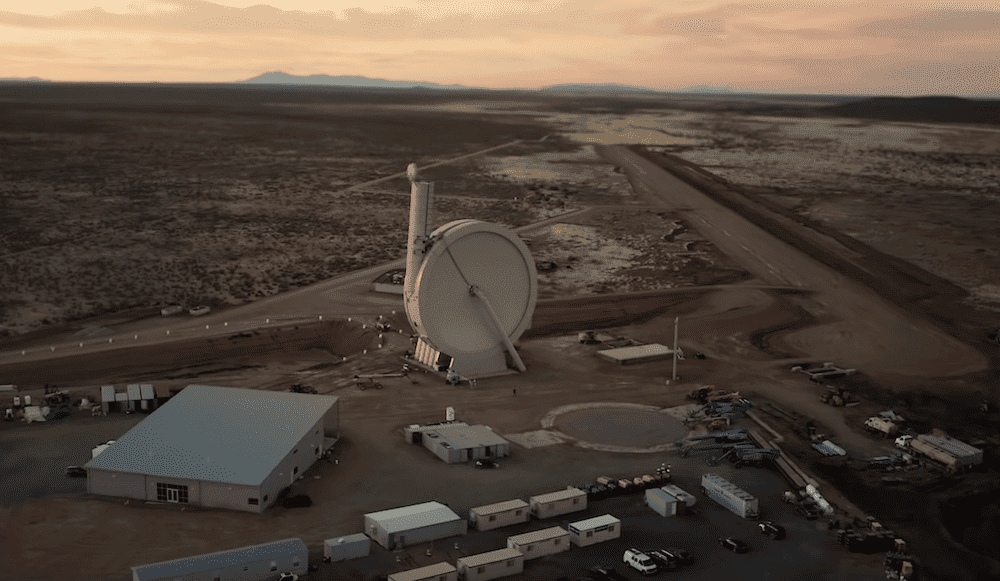
[Image above] The Suborbital Accelerator seen here is a one-third scale version of the Orbital Accelerator that SpinLaunch plans to build to launch rockets into orbit using kinetic energy. Credit: SpinLaunch, YouTube
Government agencies used to be the be-all and end-all of spaceflight. In recent years, however, private companies are taking over more of the business.
Cost savings is one of the largest factors that companies and governments point to when explaining the rise in private space flight. As explained in an op-ed by Nayef Al-Rodhan, head of the Geneva Centre for Security Policy’s Geopolitics and Global Futures Programme, “These companies must bid for NASA contracts, which lowers the taxpayer cost of these missions, as some research and development R&D costs are absorbed by the company. … [in addition] private companies must deal with a more complex web of investors/shareholders, the bottom line, and the need to keep a secure contract.”
Yet even with these benefits, the cost of spaceflight can only be lowered so much considering the way that rockets are currently launched. As explained in the video below, rockets rely on fuel to propel them upward against the pull of gravity. As you can imagine, this requires a lot of fuel, so the multistage propulsion system makes up a majority of the rocket’s mass.

Credit: Science ABC, YouTube
Once a spacecraft is in orbit, the amount of fuel needed is minimal—just enough to perform some basic maneuvers like a retro-fire to come home or a burn to transfer to another orbit. Thus, if there was another way to propel a rocket into space that did not rely on fuel, it may allow for simpler and less expensive rockets.
Scientists have proposed a number of alternative methods for launching rockets into space that would minimize or remove the need for fuel, such as air launch, cable accelerators, tether launch systems, and solar and magnetic sails. So far, though, few companies have advanced these ideas significantly toward commercial viability. SpinLaunch is an exception.
SpinLaunch is a Long Beach, California-based space technology company founded in 2014 by CEO Jonathan Yaney. The company is developing a novel ground-based system to launch rockets into orbit using kinetic energy rather than fuel.
“It’s a radically different way to accelerate projectiles and launch vehicles to hypersonic speeds using a ground-based system,” Yaney says in a CNBC article. “This is about building a company and a space launch system that is going to enter into the commercial markets with a very high cadence and launch at the lowest cost in the industry.”
SpinLaunch’s system is based on a vacuum-sealed centrifuge that spins a rocket at several times the speed of sound before releasing it into the atmosphere. The main parts of the system include
- The steel vacuum chamber, which maintains the low pressures required for sustained high-speed operation of the tether and minimizes aerothermal heating.
- The carbon fiber tether, which is spun up to launch speeds by a central electric drive.
- The adjustable launch cradle, which supports the weight of the chamber while also providing a base for the launch angle articulation mechanism.
- The exit tunnel, which features ultrahigh-speed airlock doors to prevent the vacuum chamber from re-pressurization as well as sonic flow reduction cavities to dampen the airflow entering the vacuum chamber during launch.
The ultimate goal of SpinLaunch is to create what it calls the Orbital Accelerator at a coastal location, which will feature a vacuum chamber measuring about 300 feet in diameter and spin the tether at nearly 5,000 mph. Currently, though, the company has built a one-third scale version called the Suborbital Accelerator at Spaceport America in New Mexico, which stands about 165 feet tall and allows for test spins at more than six times the speed of sound (~4,600 mph).
Since its founding, SpinLaunch has maintained a relatively low profile, per Yaney’s belief that “the more audacious and crazy the project is, the better off you are just working on it—rather than being out there talking about it,” as the CNBC article quotes. That changed on Oct. 22, 2021, when SpinLaunch successfully used about 20% of the Suborbital Accelerator’s full power capacity to send a launch vehicle to a test altitude in the tens of thousands of feet.
While this first test flight vehicle was instrumented and collected data, it did not have any active controls, instead flying a ballistic trajectory. SpinLaunch plans to add a rocket engine and other internal systems in later suborbital test flights, which it plans to conduct about 30 of in the next six to eight months.
SpinLaunch aims to advance the Orbital Accelerator and have it ready to begin launches in 2025. It will be designed to handle payloads weighing up to 200 kilograms (~440 lbs), which is equivalent to a few small satellites.
Author
Lisa McDonald
CTT Categories
- Aeronautics & Space
- Material Innovations


